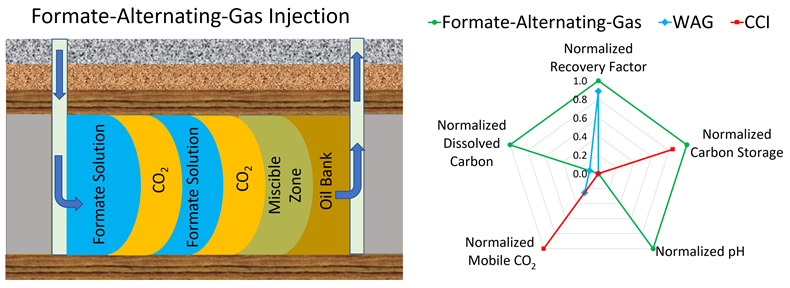Formate-Alternating-Gas Injection Method Using Aqueous Formate Solution and CO2 for Optimizing Oil Recovery, Carbon Sequestration, and Storage Security
Abouzar Mirzaei-Paiaman, and Ryosuke Okuno
Energy Fuels 2025, 39, 28, 13354–13366, https://doi.org/10.1021/acs.energyfuels.5c01678
Study Summary

In carbon capture, utilization, and storage (CCUS) integrated with enhanced oil recovery (EOR), achieving both high oil recovery and substantial, secure carbon storage is a critical challenge. Conventional injection methods entail trade-offs between these objectives. Continuous CO2 injection typically favors CO2 storage but limits oil recovery and storage security, while water-alternating-gas (WAG) injection tends to enhance oil recovery and storage security at the cost of reduced CO2 storage. This study introduces a novel injection strategy, formate-alternating-gas, which alternates between CO2 and an aqueous formate solution. Formate, a carbon carrier produced via CO2 reduction reactions, is leveraged to achieve simultaneous enhancements in oil extraction, carbon sequestration, and storage security compared to traditional methods.
A compositional simulation model of a San Andres oil reservoir in the West Texas Permian Basin was used to objectively compare continuous CO2 injection, WAG, and formate-alternating-gas in terms of oil recovery, carbon storage, and storage security under identical conditions. Formate-alternating-gas increased oil recovery by 19.5% compared to continuous CO2 injection and by 1.9% compared to WAG. Moreover, the new method achieved 2.5% higher carbon storage than continuous CO2 injection and 17.9% higher carbon storage than WAG. The alternating slugs of CO2 and viscous formate solution enhanced sweep efficiency, boosting oil production while optimizing the use of pore space for carbon storage. Furthermore, formate-alternating-gas provided the highest level of storage security, with the greatest amount of carbon stored in more stable forms (i.e., dissolution in brine and oil), and the lowest amount of carbon stored as less secure, mobile CO2. Additionally, formate-alternating-gas maintained higher pH levels, reducing the risk of mineral dissolution and potential integrity issues for caprock, cement behind casings, and sealed fractures/faults.
Why is this research important and why do the results matter?
- We introduce a novel injection strategy, formate-alternating-gas, which alternates between CO2 and an aqueous formate solution.
- Formate, a carbon carrier produced via CO2 reduction reactions, is leveraged to achieve simultaneous enhancements in oil extraction, carbon sequestration, and storage security compared to traditional methods.
- The new method reduces the risk of mineral dissolution and potential integrity issues for caprock, cement behind casings, and sealed fractures/faults.
Link(s)
Mirzaei-Paiaman, A., and Okuno, R. 2025. Formate-Alternating-Gas Injection Method Using Aqueous Formate Solution and CO2 for Optimizing Oil Recovery, Carbon Sequestration, and Storage Security. Energy Fuels, 39, 28, 13354–13366, https://doi.org/10.1021/acs.energyfuels.5c01678